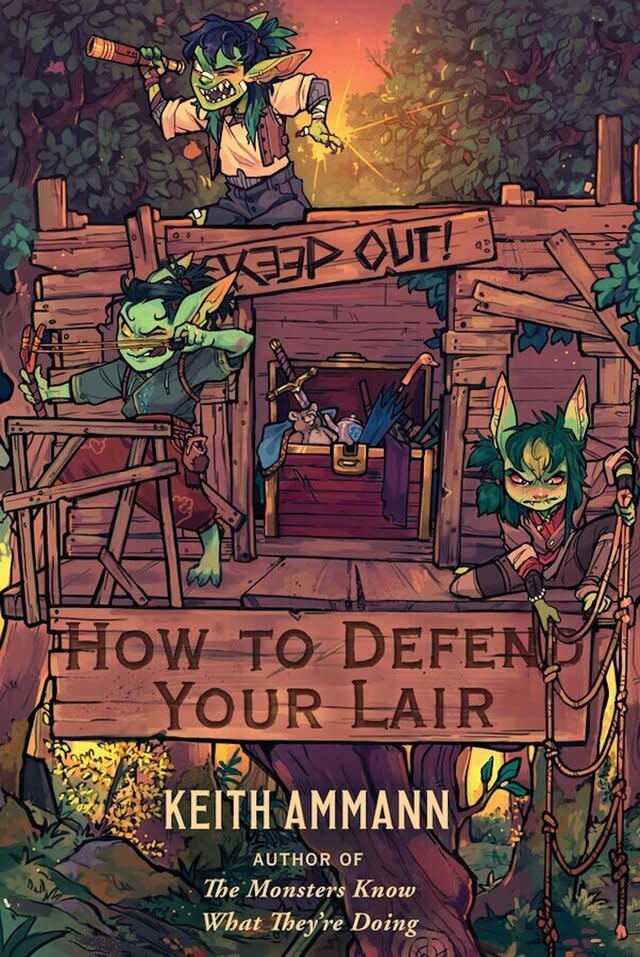'How to Defend Your Lair' teaches D&D players to make villain bases that don't stink
Woe to anybody — be they a low-level thief or a mighty dragon — who thinks they can defend themselves against a group of determined fantasy heroes. In Dungeons & Dragons, the player characters tend to find ways to get the loot they’re after. For a villain (and by extension the Dungeon Master who is playing them and created the scenario in the first place), defending a lair is no easy feat. Luckily for the Beholders and Litches out there, the new book How to Defend Your Lair will teach DMs how to do just that.
The book, on sale Nov. 29, is the work of Keith Ammann, who is also behind the popular blog The Monsters Know What They’re Doing, which helps DMs run monsters as the intelligent and exciting foes they’re meant to be rather than just generic cannon fodder. It’s a valuable resource for DMs who want to give their players a challenge and make their game feel truly immersive.
“A lot of the things that I write about I do so out of a desire to make the fantasy setting feel more real. More lived in, more internally consistent, more like a place where things are continually going on, even if they're not being acted upon by the player characters. There's a whole world always going on in the background, and NPCs and monsters are continually doing things for their own reasons,” Ammann tells SYFY WIRE. “When Dungeon Masters draw maps for locations, oftentimes they tend to have a kind of random incoherence to them that doesn't really reflect the desire of a villain, NPC, or a monster.”
The book helps guide in the creation of lairs from scratch, starting with an understanding of what the purpose of a lair is and going from there to teach DMs how to create a lair that makes sense — and there are several in-depth examples of lairs that DMs can either use whole cloth or learn from. Ammann draws on a deep understanding of the Dungeon Master's Guide and Monster Manual, a wealth of historical comparisons, and a keen understanding of how people (and monsters) tick. In an interview with SYFY WIRE, Ammann explained some of his lair-building philosophy.
What are some of the biggest mistakes DMs make when dealing with a lair?
Overlooking particular situations that create weaknesses, such as when the owner of the lair has to leave or is asleep. That means giving less attention to one of the three basic components of lair defense, which are detection, deterrents, and response. If, for example, you have detection and response, but you don't have deterrence, people are gonna be testing you all the time. You're gonna be sending off more attacks than you can handle.
I think the biggest error DMs make is simply not orienting the defense toward the protection of particular assets. A lot of the time when DMs create dungeons, the treasure is the last thing to go in. I argue in favor of using that as a starting point and constructing the lair around the defense of whatever valuables the owner of the lair has.
You draw a lot on real-world history in this book — there’s a section about castles that’s really fascinating. Can you talk about why that is, and how it impacts your lair design philosophy and advice for this fantasy roleplaying game?
The majority of the advice in the book applies regardless of the technology level. You can use it for an ancient mythological setting, or you could use it for a more industrial fantasy setting. You could use it for a contemporary or a science fiction setting because the principles apply regardless of the level of technology. I look back at history because it provides concrete illustrations of what can be done and what has been done.
Can you talk about how magic impacts lair balance and design, and speak to how your book addresses this fantastical element? Defending a lair becomes a lot harder when somebody can just magically turn a stone wall into a doorway.
You have to assume that the more magic there is in the world, the more magic is available to everybody for their defense. If the number of people in the population that can read minds is 20 percent as opposed to, you know, 1 or 2 percent, then you have everybody of any importance at all walking around wearing magical talismans that protect them against mind reading. The more magic becomes like technology, the more you get into a technological arms race when it's available to everybody. And because magic is very flexible by its nature, you start to have to account for more and more and more and more and plan different contingencies. It becomes super difficult. You really then have to think very long and hard and carefully about who your biggest enemies are and what they in particular can do to you (or are likely to try to do to you). Then you just move on to the next one, and then the next one, and the next one. It just becomes vastly more work.

How To Defend Your Lair Photo: Saga Press
There's a lot of great design philosophy in this book. How do you transition that into rules and gameplay? Like, now I understand what my goblins are protecting and what they're doing. How do I turn that into a map? How do I turn that into a game?
It's really not that hard. All it is is guiding you. The DM is doing the same things that they always would in terms of populating the lair, drawing the map, and choosing treasure, but in a different order and with a different set of considerations. It's not that there's any great mechanical difference, but rather that you're starting from a different set of questions and asking a different set of questions as you go.
The Dungeon Master is not only the creator of the world but also the arbitrator of the rules. They have to have a grounding in the rules and they think about the implications of certain rules on gameplay. That is something I deal with a lot. For example, in the chapter about terrain and in the magic chapter, where certain terrain or certain spells have game rules associated with them. On a meta-level, those rules are things that the owner of the lair can work to their advantage and incorporate as they're building the lair to make sure that they have that little edge against anyone who tries to invade.
Does this book make DMs… too powerful? I am a DM myself, and while I love my players, I can see a world where if I threw some of the stuff you recommend in this book at them, they’d be totally in over their heads.
That's a valid fear, but also one that is kind of contradicted by the very common complaint among DMs — particularly in Fifth Edition — that, especially at higher levels, it's just too difficult to challenge their players, that they walk through encounter after encounter after encounter without breaking a sweat. At very low levels [an optimized lair] could potentially be very deadly. But the flip side of that is that at very low levels, you tend to be going up against adversaries that don't really have a lot of resources to work with and can't build a particularly elaborate lair. They might have to rely on just one or two key defensive measures in order to protect their lairs as opposed to a whole panoply of them. I think generally the greater worry among DMs is simply being able to challenge their players enough.
And, I do have a little bit of material in the book where I give advice on how to balance things. For example, massing combat power is a smart move, but you cannot pile an implausible and unsustainable amount of combat power into your lair. Number one, because you can't justify it. Number two, because it will turn the experience into a wood chipper for your PCs and nobody wants that. What you want is to get your players thinking that they have a big obstacle to overcome in front of them and that they need to be creative about how they go about it. Even the best lair is going to have loopholes. They might not be the obvious loopholes, but they will be there. And if your players sit down and take the time to think about it, they're gonna find them. Because RPG players are very creative.
How to Defend Your Lair is available now.
Looking for a fantasy experience? Stream Warcraft on Peacock.


